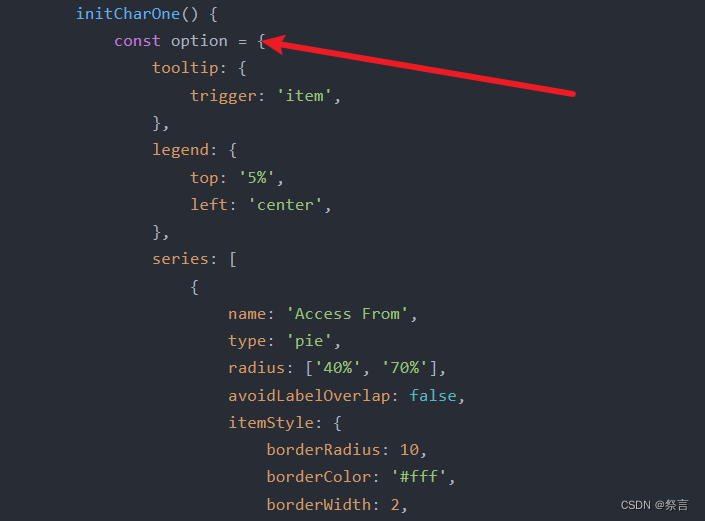主要内容:mqtt的连接,组件之间传参,加入echarts表格
目录
主要内容:mqtt的连接,组件之间传参,加入echarts表格
1.mqtt连接:
mqtt的连接较为简单,主要使用以下页面的内容即可,为了以防万一在这里存入一份
如何在 Vue 项目中使用 MQTT | EMQ (emqx.com)
安装 MQTT 客户端库
以下 2,3 方法更适用于通过直接引用 Vue.js 创建的 Vue 项目。
-
通过命令行安装,可以使用 npm 或 yarn 命令(二者选一)选择下载4.3.7版本
-
npm install mqtt --saveyarn add mqtt -
通过 CDN 引入
<script src="https://unpkg.com/mqtt/dist/mqtt.min.js"></script> -
下载到本地,然后使用相对路径引入
<script src="/your/path/to/mqtt.min.js"></script>引入后要在vue.config.js中添加:

MQTT 的使用
连接 MQTT 服务器
连接关键代码:
<script>
import mqtt from "mqtt";
export default {
data() {
return {
connection: {
protocol: "ws",
host: "broker.emqx.io",
// ws: 8083; wss: 8084
port: 8083,
endpoint: "/mqtt",
// for more options, please refer to https://github.com/mqttjs/MQTT.js#mqttclientstreambuilder-options
clean: true,
connectTimeout: 30 * 1000, // ms
reconnectPeriod: 4000, // ms
clientId: "emqx_vue_" + Math.random().toString(16).substring(2, 8),
// auth
username: "emqx_test",
password: "emqx_test",
},
subscription: {
topic: "topic/mqttx",
qos: 0,
},
publish: {
topic: "topic/browser",
qos: 0,
payload: '{ "msg": "Hello, I am browser." }',
},
receiveNews: "",
qosList: [0, 1, 2],
client: {
connected: false,
},
subscribeSuccess: false,
connecting: false,
retryTimes: 0,
};
},
methods: {
initData() {
this.client = {
connected: false,
};
this.retryTimes = 0;
this.connecting = false;
this.subscribeSuccess = false;
},
handleOnReConnect() {
this.retryTimes += 1;
if (this.retryTimes > 5) {
try {
this.client.end();
this.initData();
this.$message.error("Connection maxReconnectTimes limit, stop retry");
} catch (error) {
this.$message.error(error.toString());
}
}
},
createConnection() {
try {
this.connecting = true;
const { protocol, host, port, endpoint, ...options } = this.connection;
const connectUrl = `${protocol}://${host}:${port}${endpoint}`;
this.client = mqtt.connect(connectUrl, options);
if (this.client.on) {
this.client.on("connect", () => {
this.connecting = false;
console.log("Connection succeeded!");
});
this.client.on("reconnect", this.handleOnReConnect);
this.client.on("error", (error) => {
console.log("Connection failed", error);
});
this.client.on("message", (topic, message) => {
this.receiveNews = this.receiveNews.concat(message);
console.log(`Received message ${message} from topic ${topic}`);
});
}
} catch (error) {
this.connecting = false;
console.log("mqtt.connect error", error);
}
},
},
};
</script>订阅主题
doSubscribe() {
const { topic, qos } = this.subscription
this.client.subscribe(topic, { qos }, (error, res) => {
if (error) {
console.log('Subscribe to topics error', error)
return
}
this.subscribeSuccess = true
console.log('Subscribe to topics res', res)
})
}取消订阅
doUnSubscribe() {
const { topic } = this.subscription
this.client.unsubscribe(topic, error => {
if (error) {
console.log('Unsubscribe error', error)
}
})
}消息发布
doPublish() {
const { topic, qos, payload } = this.publish
this.client.publish(topic, payload, { qos }, error => {
if (error) {
console.log('Publish error', error)
}
})
}断开连接
destroyConnection() {
if (this.client.connected) {
try {
this.client.end(false, () => {
this.initData()
console.log('Successfully disconnected!')
})
} catch (error) {
console.log('Disconnect failed', error.toString())
}
}
}2.组件之间相互传参:
这个也是我在网上找到的方法,把链接放在这里
(19条消息) vue任意两个组件的传值(事件总线)_jaykeler的博客-CSDN博客
总结一下就是
先在main.js加入:
var bus = new Vue()//新创建一个实例,用以传值
Vue.prototype.bus = bus//挂载在vue的原型上
在需要传值的页面的method放入:
sendTo () {
this.bus.$emit('sendTo', this.name)//注册事件,传值
}接收页面的mounted或者created放入:
this.bus.$on('sendTo', name=> {
this.a= name
})两个sendTo只要相同就可以进行接收
3.加入echarts表格
首先将组件进行添加:
npm install echarts --save然后在main.js中注册
import * as echarts from 'echarts'
Vue.prototype.$echarts = echarts然后在template组件中
<div class="datamap">
<div id="one"></div>
</div>在script中
export default {
name: 'dataview',
data() {
return {}
},
mounted() {
this.init()
},
methods: {
init() {
setTimeout(() => {
this.initCharOne()
}, 1000)
},
//两个图标的生成函数
initCharOne() {
const option = {
tooltip: {
trigger: 'item',
},
legend: {
top: '5%',
left: 'center',
},
series: [
{
name: 'Access From',
type: 'pie',
radius: ['40%', '70%'],
avoidLabelOverlap: false,
itemStyle: {
borderRadius: 10,
borderColor: '#fff',
borderWidth: 2,
},
label: {
show: false,
position: 'center',
},
emphasis: {
label: {
show: true,
fontSize: 40,
fontWeight: 'bold',
},
},
labelLine: {
show: false,
},
data: [
{ value: 1000, name: '优' },
{ value: 735, name: '良' },
{ value: 580, name: '中' },
{ value: 484, name: '差' },
],
},
],
}
var myChartOne = this.$echarts.init(document.getElementById('one')) //图标初始化\
myChartOne.setOption(option)
window.onresize = function () {
myChartOne.resize()
}
},
}注意:
当你需要什么图表的时候就去echarts官网找,然后将option的按上面的代码进行修改即可;

改为:


这一部分内容也记得需要更改,其中one就是上面容器中的one,需要与容器进行对应
在style中:
<style scoped>
.datamap #one {
height: 500px;
}
</style>





















 773
773











 被折叠的 条评论
为什么被折叠?
被折叠的 条评论
为什么被折叠?








